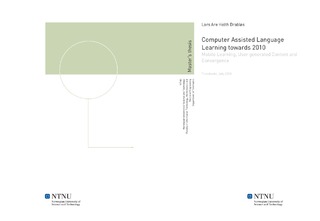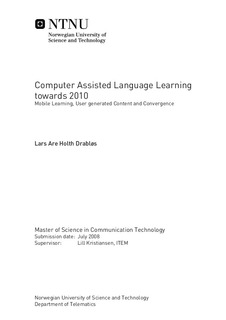| dc.description.abstract | Many topics have been touched in this thesis. I would like to conclude with some answers to the questions raised in the initial problem description and point out further challenges in some cases. We have seen that there exist several approaches for CALL, with virtual learning communities as one example. The community presented here, moodle.org, is an open source framework and let any user register for free and manage a course. In that way may this framework be used by school institutions, professional language course providers and other users who feel free to organize a course. This environment is quite formal in nature, because most of the use at the portal is related to a registered course. Another portal, italki.com, offers language learning after the tandem method and users are free to search among all (visible) profiles on the sites to find a match. This is a more informal framework as the users are not connected to any established educational institution, they do not necessarily follow a curriculum and the learning is not instructed to follow any pedagogical principles. These portals may be accessed both in stationary and mobile environments (by mobile browsers). In the case of mobile environments there exist many challenges: Developers of the site are requested to take special considerations of how some material is to be structured to fit the interface at the user s terminal. One of the considerations at moodle.org was for instance to limit graphical content (illustrated in chapter 5.2.1), as this takes up much space on the screen and uses quite a bit bandwidth to download. Other challenges can be related to media richness and context awareness discussed in chapter two. One example could for instance be a video conference lecture held at a moodle course. If some of the users are in a mobile environment without the possibility to transfer video (because of terminal or bandwidth limitation), they should still be given the option of following the lecture by audio transmission. This will reduce the richness of the lecture, but they will be able to catch up the most essential things. BBC offers another kind of framework which is typically meant for beginner learners in a language. The material in Language steps is instructional and interactive, as it requires response and apprehension from the users. This makes it most suitable for stationary environments, but the content could be presented in a mobile environment to. The 3 Rearranging the dialogue task will probably be suitable for a touch screen handheld. The content in the different modules could also be categorized to fit the current response flexibility of the user. An example of different categories was given in chapter 2. Another framework presented from the BBC portal was their show The Flatmates . This is an internet based soap show where the episodes can be followed by downloadable tracks or simply be read. The users may contribute to the show with discussion about the characters and give feedback about how the show should continue. This is a good example of how the Internet can be used as a platform for participation among users. There also exist mobile applications like KODI s dictionary and Coolgorilla s audio phrase books. These can be categorized as referential tools and can be used in many settings, remarking that the audio phrase books in most cases are suited for beginners on vacation in the target language country. Chapter 6 discussed general possibilities and challenges related to technology and market trends. Web 2.0 was presented as the future trend of Internet usage and web design with key words as creativity, information sharing and collaboration between users (and companies). A survey, held by the Norwegian institute ITU has showed that Norwegian teenagers at average participate in 3,4 network societies . Facebook was the most popular. The biggest reason to participate in the networks was to meet friends. Only 8 percent answered that the networks provided help for school related topics. This shows that most of the interaction in these networks are informal among the teenagers. Could we still expect more participation in school related topics in such networks? The answer is yes, and no. The technology exists to promote school related subjects in these networks, but it would be a challenge to mix the pupils (and the teacher s) roles in such a situation, as depicted in chapter 6.3. Hans Christian Arnseth also points out in [46] that the question about using more web 2.0 applications in the school system is much about ideology What do we regard as proper learning and how can/should technology be used in the education? . At last were some general challenges related to technology presented, with issues around convergence, human aspects, business models and policy as the main issues. Copyright policy and business models can be even more complicated in the evolution of web 2.0 interfaces, where content sharing and user participation goes hand in hand. | nb_NO |

